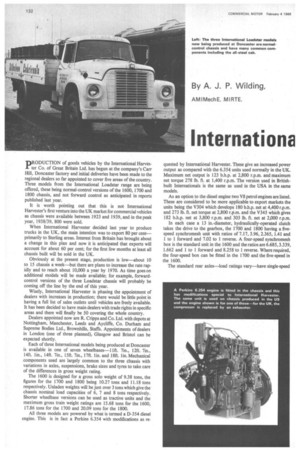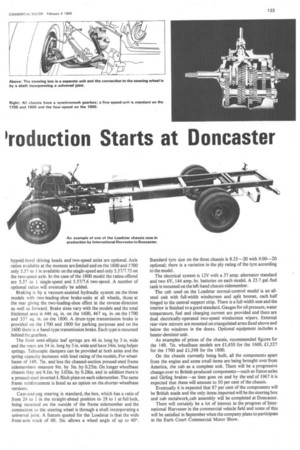Internationa 'roduction Starts at Doncaster
Page 134

Page 135

If you've noticed an error in this article please click here to report it so we can fix it.
By A. J. P. Wilding,
AMIMechE, MIRTE.
PRODUCTION of goods vehicles by the International Harvester Co. of Great Britain Ltd. has begun at the company's Carr Hill, Doncaster factory and initial deliveries have been made to the regional dealers so far appointed to cover five areas of the country. Three models from the International Loadstar range are being offered, these being normal-control versions of the 1600, 1700 and 1800 chassis, and not forward control as anticipated in reports published last year.
It is worth pointing out that this is not International Harvester's first venture into the UK market for commercial vehicles as chassis were available between 1923 and 1939, and in the peak year, 1938/39, 800 were sold.
When International Harvester decided last year to produce trucks in the UK, the main intention was to export 80 per cent— primarily to Sterling areas. Interest from Britain has brought about a change in this plan and now it is anticipated that exports will account for about 60 per cent; for the first few months at least all chassis built will be sold in the UK.
Obviously at the present stage, production is low—about 10 to 15 chassis a week—but there are plans to increase the rate rapidly and to reach about 10,000 a year by 1970. As time goes on additional models will be made available; for example, forwardcontrol versions of the three Loadstar chassis will probably be coming off the line by the end of this year.
Wisely, International Harvester is phasing the appointment of dealers with increases in production; there would be little point in having a full list of sales outlets until vehicles are freely available. It has been decided to have main dealers with trade rights in specific areas and there will finally be 50 covering the whole country.
Dealers appointed now are R. Cripps and Co. Ltd. with depots at Nottingham, Manchester, Leeds and Aycliffe, Co. Durham and Supreme Bodies Ltd., Brownhills, Staffs. Appointments of dealers in London (one of three planned), Glasgow and Bristol can be expected shortly.
Each of three International models being produced at Doncaster is available in one of seven wheelbases-1111. 7in., 1211. 7in., 14ft. lin., 14ft. 7in., 1511. 7in., 1711. lin. and 1811. lin. Mechanical components used are largely common to the three chassis with variations in axles, suspensions, brake sizes and tyres to take care of the differences in gross weight rating.
The 1600 is designed for a gross solo weight of 9.38 tons, the figures for the 1700 and 1800 being 10.27 tons and 11.18 tons respectively. Unladen weights will be just over 3 tons which give the chassis nominal load capacities of 6, 7 and 8 tons respectively. Shorter wheelbase versions can be used as tractive units and the maximum gross train weight ratings are 15.68 tons for the 1600, 17.86 tons for the 1700 and 20.09 tons for the 1800.
All three models are powered by what is termed a D-354 diesel engine. This is in fact a Perkins 6.354 with modifications as re
quested by International Harvester. These give an increased power output as compared with the 6.354 units used normally in the UK. Maximum net output is 123 b.h.p. at 2,800 r.p.m. and maximum net torque 278 lb. ft. at 1,400 r.p.m. The version used in Britishbuilt Internationals is the same as used in the USA in the same models.
As an option to the diesel engine two V8 petrol engines are listed. These are considered to be more applicable to export markets the units being the V304 which develops 180 b.h.p. net at 4,400 r.p.m. and 273 lb. ft. net torque at 2,800 r.p.m. and the V345 which gives 182 b.h.p. net at 3,800 r.p.m. and 303 lb. ft. net at 2,000 r.p.m.
In each case a 13 in.-diameter, hydraulically-operated clutch takes the drive to the gearbox, the 1700 and 1800 having a fivespeed synchromesh unit with ratios of 7.17, 3.96, 2.365, 1.41 and 1 to 1 forward and 7.02 to 1 reverse. A four-speed synchromesh box is the standard unit in the 1600 and the ratios are 6.685,3.339, 1.662 and 1 to 1 forward and 8.258 to 1 reverse. Where required, the four-speed box can be fitted in the 1700 and the five-speed in the 1600.
The standard rear axles—load ratings vary—have single-speed
hypoid-bevel driving heads and two-speed axles are optional. Axle ratios available at the moment are limited and on the 1600 and 1700 only 5.57 to 1 is available on the single-speed and only 5.57/7.75 on the two-speed axle. In the case of the 1800 model the ratios offered are 5.37 to 1 single-speed and 5.57/7.6 two-speed. A number of optional ratios will eventually be added.
Braking is by a vacuum-assisted hydraulic system on the three models with two-leading-shoe brake-units at all wheels, those at the rear giving the two-leading-shoe effect in the reverse direction as well as forward. Brake sizes vary with the models and the total frictional area is 446 sq. in. on the 1600, 467 sq. in. on the 1700 and 537 sq. in. on the 1800. A drum-type transmission brake is provided on the 1700 and 1800 for parking purposes and on the 1600 there is a band-type transmission brake. Each type is mounted behind the gearbox.
The front semi-elliptic leaf springs are 46 in. long by 3 in. wide and the rears are 54 in. long by 3 in. wide and have 34in. long helper springs. Telescopic dampers can be provided at both axles and the spring capacity increases with load rating of the models. For wheelbases of 14ft. 7in. and less the channel-section pressed-steel frame sidemembers measure 9in. by 3in. by 0.25in. On longer wheelbase chassis they are 9.1in. by 3.03in. by 0.28in. and in addition there is a pressed-steel inverted-L flitch plate on each sidemember. The same frame reinforcement is listed as an option on the shorter-wheelbase versions.
Cam-and-peg steering is standard, the box, which has a ratio of from 24 to 1 in the straight-ahead position to 28 to I at full lock, being mounted on the outside of the frame sidemember and the connection to the steering wheel is through a shaft incorporating a universal joint. A feature quoted for the Loadstar is that the wide front-axle track of 6ft. 5in. allows a wheel angle of up to 40°. Standard tyre size on the three chassis is 8.25-20 with 9.00-20 optional; there is a variation in the ply rating of the tyre according to the model.
The electrical system is 12V with a 37 amp. alternator standard and two 6V, 144 amp.-hr. batteries on each model. A 25.7 gal. fuel tank is mounted on the left-hand chassis sidemember.
The cab used on the Loadstar normal-control model is an allsteel unit with full-width windscreen and split bonnet, each half hinged to the central support strip. There is a full-width seat and the interior is finished to a good standard. Gauges for oil pressure, water temperature, fuel and charging current are provided and there are dual electrically-operated two-speed windscreen wipers. External rear-view mirrors are mounted on triangulated arms fixed above and below the windows in the doors. Optional equipment includes a heater-demister unit.
As examples of prices of the chassis, recommended figures for the 14ft. 7in. wheelbase models are £1,450 for the 1600, £1,527 for the 1700 and £1,598 for the 1800.
On the chassis currently being built, all the components apart from the engine and some small items are being brought over from America, the cab as a complete unit. There will be a progressive change-over to British-produced components—such as Eaton axles and Girling brakes—as time goes on and by the end of 1967 it is expected that these will amount to 50 per cent of the chassis.
Eventually it is expected that 87 per cent of the components will be British made and the only items imported will be the steering box and cab metalwork,cab assembly will be completed at Doncaster.
There will certainly be a lot of interest in the progress of International Harvester in the commercial vehicle field and some of this will be satisfied in September when the company plans to participate in the Earls Court Commercial Motor Show.




































































































































































































